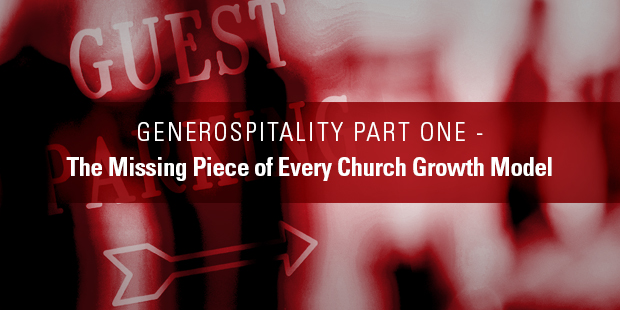Very few leaders possess what I refer to as “Stadium Filling Charisma.”
You know what I mean, a personality that is larger than life and people flock to be around that person.
When they are in the lobby of the church there is always a crowd of maybe 20 — 25 – 30 people gathered around them!
I don’t have that kind of charisma, do you?
The good news is, that kind of charisma is not a qualifier for you to become a great leader.
In fact, in some cases, it can be a detriment. Organizations tied to a leader with a big personality can become dependent on that person.
That can happen even at a church campus, a ministry team, or in a small group. That isn’t always the case, of course, but the point is, don’t assume that’s the ideal.
And most importantly, don’t think you are handicapped as a leader if you don’t have a big outgoing persona.
That said, some degree of an appealing personality is necessary to lead effectively, and to that end, everyone can have what I refer to as “Relational Charisma.”
However, relational charisma is not defined by the size of your personality, but the generosity of your spirit.
Many great leaders with a high quotient of relational charisma are more subdued, thoughtful, and some have a slight bent toward introversion.
So when it comes to charisma, don’t think personality, think intentionality.
Relational charisma is a kind of personal magnetism that everyone can have. If you want it, and if you are willing to work on it intentionally, it’s yours to develop.
Relational charisma carries an authentic personal appeal that endears people to you and allows you to lead more effectively.
This is the foundational practice to develop relational charisma:
When you walk into a room,
focus on helping the people in the room to feel better about who they are,
rather than causing the people to feel better about who you are.
In other words, make it about them, not you.
In concept, it’s simple, but in practice, it can be challenging to remain consistent with this idea. We all get what it feels like to be moving fast, and under pressure with lots to do! That truth about leadership makes it more challenging than it appears.
It’s really more of a way of life; that is often life-changing for both you and those you are around.
A quick list of 4 things that will shut down your relational charisma:
- Insecurity – You are focused on or worried about what others think of you.
- Lack of social-awareness – You fail to notice or be aware of what is happening in the room.
- Pre-occupied or distracted – Your body may be in the room, but your mind and heart are elsewhere.
- Image focused – You walk into a room, and it’s all about you. How the people see you, the impression you make, connecting only with people who can help you, and your agenda.
4 characteristics that enable you to live out a genuine sense of relational charisma consistently:
1) You genuinely love and care about people.
You know if you sincerely care about others and when you don’t. My assumption is that you do!
However, it is possible to want to care, but without gaining some ground in self-confidence and self-awareness, it is difficult to genuinely care because you are consumed with your own concerns.
This is not an indictment; it’s an encouragement to give yourself grace and work on self-confidence and self-awareness. The idea is this, when you set your needs and wants aside, and focus on others, you become a “larger” and more effective leader.
2) You have a sense that something is happening that is bigger than you are.
Have you ever walked into a room and wondered what God thinks about what’s happening in the room?
It’s a great way to approach your spiritual leadership and embrace relational charisma.
Who would Jesus want to talk with? What would he say? What would He want to see happen in the room?
When you practice that kind of thinking, you gain a sense of something larger, a glimpse of eternity. You connect with the Kingdom of God and the body of Christ in a deeper way.
3) You possess a healthy sense of self-confidence.
A healthy self-confidence means you think about yourself the way that God does, nothing more and nothing less. With that as a foundation, when you believe in yourself, you know who you are, and you like who you are, your confidence as a leader increases tremendously.
You possess a sense of personal security that allows you to make your presence in the room about others and not about yourself.
In general, you think to yourself, “I can do this.” Not out of personal bravado, but from an inner sense that God is with you.
4) You possess a strong degree of self-awareness.
If a leader walks into a room and is mostly unaware about what is going on with others, and or has little idea how he or she is perceived as a person and a leader, their social awareness is low.
Gaining a stronger sense of social-awareness begins with a healthy sense of self-awareness and personal security.
Knowing who you are, your strengths and weaknesses, abilities and capacity, etc., help you become more secure in yourself. That security creates mental and emotional margin that allows you to be more aware of others, and available to them at a heart level.
In a practical summary, relational charisma looks like this when you “walk into the room.”:
You embody a positive spirit and sense of hope about the future.
This point is about your personality. You can be an easy-going person and still be positive, hopeful, and bring some energy to the conversation.
You ask questions and listen well.
Make it about their agenda, not yours. Smile, and if you don’t know them, learn their name quickly. Approach them, don’t wait for people to find you, take the initiative.
You look for the best and believe in each person you connect with.
It’s easy to find good stuff about people when you look for it.
You encourage sincerely.
You just can’t encourage people too much. The most important element in your encouragement of others is sincerity. People see and smell surface level hot air really fast.
You add value to others.
Ultimately your role as a leader is to add value to a person’s walk with God that results in their spiritual growth as a disciple of Christ.
Adding value, however, is not limited in its scope. It includes a vast range of practical value, such as helping people to be better leaders, parents, friends, and spouses, etc. I hope you lean into relational charisma as a natural part of your life. It truly makes a life-changing difference for you and for those you lead.
> Read more from Dan.

Tags: Dan Reiland, Leadership, Relational Leadership
|
What is MyVisionRoom? > | Back to Leadership >

































